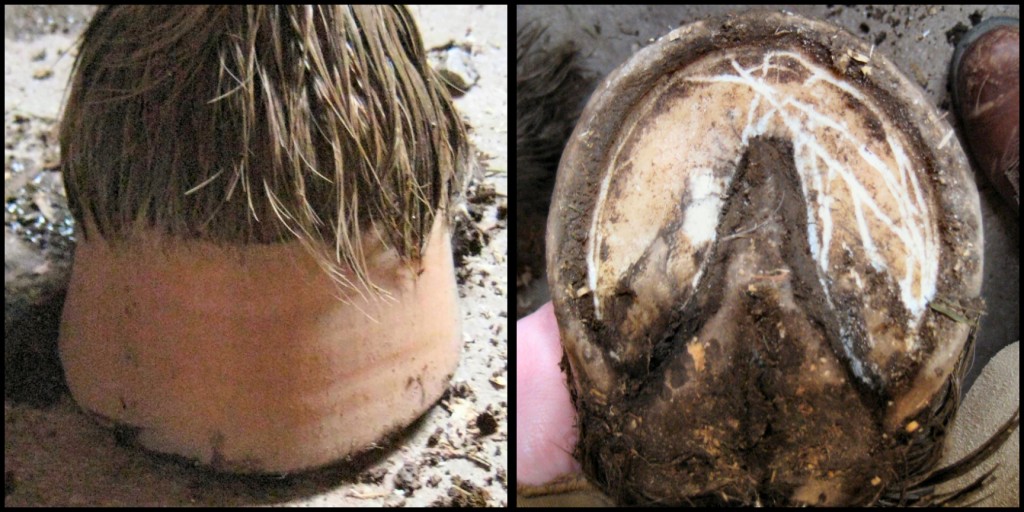One of the many benefits of proper natural hoof care, as I’ve touched on in the past, is the way the hooves tend to retain their shape as they grow. The majority of my clients comment that before beginning natural hoof care, they knew when their horse was due for a trim by the presence of chips, splits, flare, and/or other commonly-cited indicators of excessive length. But in reality, these seem to be indicators more of the combination of improper trimming and excessive length. While it’s absolutely the case that an excessively-long hoof may have a chunk or two of the excess wall broken off if the horse comes down on a rock in just the right way, I more often encounter hooves like the following –
 This young horse, who’s been a client since his very first trim, had an extra 12% – 16% of his hoof length as new growth, yet his feet looked remarkably good (albeit extremely muddy!). Notice how even the growth is, with no evident asymmetrical wear. This isn’t because he was born with “good hooves;” these hooves have been created by an owner who understands the importance of good nutrition, adequate exercise, and proper environment, coupled with trimming in accordance with how the horse moves. And since he’s moving and landing properly, the hoof continues to grow and wear evenly.
This young horse, who’s been a client since his very first trim, had an extra 12% – 16% of his hoof length as new growth, yet his feet looked remarkably good (albeit extremely muddy!). Notice how even the growth is, with no evident asymmetrical wear. This isn’t because he was born with “good hooves;” these hooves have been created by an owner who understands the importance of good nutrition, adequate exercise, and proper environment, coupled with trimming in accordance with how the horse moves. And since he’s moving and landing properly, the hoof continues to grow and wear evenly.
When hooves are trimmed to the correct length and properly balanced, which includes the application of a “mustang roll” on the outer edge of the bearing surface of the hoof wall, the mechanical forces that oppose efficient movement are minimized. In other words, because we’ve removed the hoof material that “gets in the way” of the horse moving properly (as nature will do, given the right environment), plus made certain the hoof is landing with minimal impact, the hoof has no “reason” to break or distort. And I suspect that the minimal-impact landing, which evenly distributes the forces of impact, is particularly important because, I think, the increased localized stresses of an unbalanced landing probably cause structural damage at the lamellar level that result in localized hoof wall weaknesses, predisposing the hoof to chips, cracks, and other distortions. Here are the “after” photos of the same foot; a little cleaner and a lot shorter – Can anything disturb this situation? Of course. If the horse is living in an excessively-wet environment, particularly a urine-laden one, the quality of growth can be adversely affected. And if the horse is eating too many calories for the amount of work he/she is doing, inflammation of the laminae (laminitis) can damage the integrity of the coffin bone-hoof capsule junction. But, in my experience, the hooves of a horse receiving proper trimming will tend to maintain their shape long after they’re due for a trim.
Can anything disturb this situation? Of course. If the horse is living in an excessively-wet environment, particularly a urine-laden one, the quality of growth can be adversely affected. And if the horse is eating too many calories for the amount of work he/she is doing, inflammation of the laminae (laminitis) can damage the integrity of the coffin bone-hoof capsule junction. But, in my experience, the hooves of a horse receiving proper trimming will tend to maintain their shape long after they’re due for a trim.
Your horse, too, can have healthy, properly-functioning, and beautiful feet!